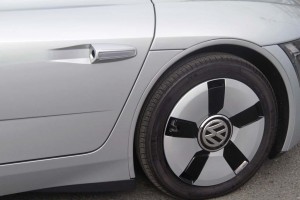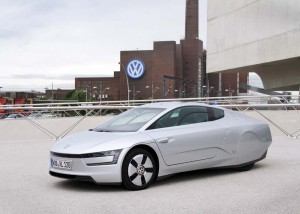When Volkswagen begins delivering the first of its ultra-efficient XL1 coupes by mid-year, motorists will have to get used to the idea of looking at a set of three video screens, rather than rear and side-view mirrors, to see what’s happening around them.
By replacing the traditional mirrors with micro-compact cameras built into the subcompact car’s body, VW designers were able to significantly improve the XL1’s aerodynamics, a critical factor in helping it achieve a record fuel economy of 235 miles per gallon.
VW plans to build only 250 of the little cars – and none will be shipped to the U.S., in part, because federal rules require all vehicles be equipped with left and right-side exterior mirrors. But that could soon change. At least, the auto industry is hoping so. The Alliance of Automobile Manufacturers, a consortium that includes VW, Toyota and General Motors – as well as start-up Tesla Motors – has petitioned the National Highway Traffic Safety Administration to begin permitting manufacturers to replace mirrors with digital cameras.

Special cladding on the tires and a compact camera replaces traditional side view mirrors on the VW XL1.
The request comes on the heels of an announcement by NHTSA outlining a long-delayed mandate that will require all vehicles to be equipped with backup cameras starting with the 2018 model-year. Studies have suggested that move could save 100s of lives and prevent 1,000s of injuries each year.
Automotive regulators have earned a reputation for being slow to change existing mandates, in this case Federal Motor Vehicle Safety Standard, or FMVSS, 111. It took several years longer than expected to put the backup camera guidelines in place, and even adjusting rules covering the acceptable color of an instrument panel warning light has been known to take years.
“You can actually get these things changed, but it takes ages,” lamented Tesla CEO Elon Musk during an industry conference last year. The maker would like to carry over the side cameras shown on its Model X SUV concept and use them on a production version.
Nonetheless, automakers are hoping that the time is finally right to accept a high-tech alternative to the basic outside mirror – especially since using digital cameras could allow the integration of advanced safety systems, such as blind-spot warning.

Tesla's Model X, the company's next gen vehicle, also utilizes cameras instead of traditional side view mirrors.
The concept of using more aerodynamic cameras has been something automotive designers and engineers have been exploring for decades. Indeed, concept cars using the concept have been around since at least the 1960s, well before the technology was actually advanced enough to use in a vehicle. Today, however, digital cameras are found just about everywhere and costs are expected to plunge as volumes rise.
(VW launching 261 mpg XL1 hybrid. For more, Click Here.)
Backup cameras, for example, could cost as little as $43 to $45 apiece, NHTSA estimates, if a vehicle already has a suitable video display screen. Side-view cameras would likely run a bit more as they’d need a suitable, aerodynamic housing and separate screens. But costs are no longer considered prohibitive – especially on the sports cars and luxury vehicles that would likely be first to make use of the technology.
Last month’s move to set a timetable for installing backup cameras could be the signal the industry is waiting for. But makers have also taken preliminary steps they hope will ease any lingering concerns on the part of NHTSA rulemakers.
(Click Here for details about all vehicles having backup cameras by 2018.)
Honda, for example, launched its LaneWatch system with the debut of the new 2013 Accord model. The car still has the requisite side-view mirrors but is also equipped with a camera that peers into the passenger-side blind spot that motorists normally miss. The image is displayed on the same center console-mounted screen that normally handles navigation and infotainment duties.
Nissan, meanwhile, uses a network of cameras mounted around the vehicle to give a motorist a birds-eye view of surrounding pavement and obstacles through its AroundViewMonitor.
(To see more about Chrysler’s recall of 900,000 SUVs, Click Here.)
Going forward, a smart digital “mirror” could flag a driver’s attention to objects in a vehicle’s blind spot.
How soon NHTSA might respond to the Alliance’s petition remains to be seen but industry planners are hoping they could see the government move with reasonable haste this time.


I MUCH prefer mirrors to cameras. We’ll see if the accident rate increases as people ignore cameras.